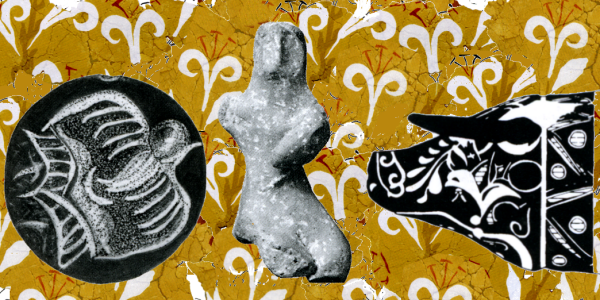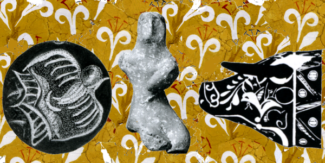Kommos and Myths

Poetry and Art with further musings on the ancient stories in the context of the Cretan Bronze Age
09 December 2015 Introduction by R. C. Bigelow
Kate Tempest’s poem, Icarus, is a dynamic, interesting, and insightful re-telling of and comment on the myths of Daedalus and Icarus. Now other poetry and visual art related to these myths are being posted on this website, including works by Loes Huis in ‘t Veld, Renate Stollenwerk and Wendy Everett. Clearly the poignancy of the doomed Icarus still has the power to inspire art. But how might these myths relate to Kommos?

Almost nothing else about Icarus is known except the myth of flying too close to the sun. By contrast, there are many stories about Daedalus. The well known story of Daedalus and Icarus is of Athenian origin. It is incidental, from their viewpoint, to the the exploits of Theseus as told by Pseudo-Apollodorus, in Bibliotheca, Ovid in Metamorphoses, and Plutarch in Theseus; all from around the first century CE. It is from them that we learn Daedalus supposedly built a wooden cow for Pasiphaë, King Minos’ wife, to hide in so she could mate with a sacred Bull. He also built the Labyrinth for Minos to imprison her monstrous offspring, the Minotaur. He, too, gives Minos’ daughter, Ariadne the thread that Theseus uses to find his way out of the Labyrinth after killing the Minotaur and of course, he builds wings for himself and for his son Icarus to fly from Crete. The Athenians claim Daedalus as one of their own and are at great pains to present him as a genius, but still an ordinary man and, to the extent possible, their version of his myth eliminates any supernatural abilities on his part.
But Daedalus appears much earlier, in Homer, where he is described as building a “dancing ground” for Ariadne. That dancing ground is sometimes identified with the Labyrinth which was initially synonymous with the palace of Minos. Here we may be glimpsing a much earlier, Cretan Minoan myth. Wikipedia’s entry for Ariadne notes that:
Karl Kerenyi and Robert Graves theorize that Ariadne (whose name they derive from Hesychius’s listing of Άδνον, a Cretan-Greek form for arihagne, “utterly pure”) was a Great Goddess of Crete, “the first divine personage of Greek mythology to be immediately recognized in Crete”, once archaeology had begun. Kerenyi observes that her name is merely an epithet and claims that she was originally the “Mistress of the Labyrinth”, both a winding dance-ground and, in the Greek view, a prison with the dreaded Minotaur at its center. Kerenyi notes a Linear B inscription from Knossos, “to all the gods, honey… to the mistress of the labyrinth honey” in equal amounts, suggesting to him that the Mistress of the Labyrinth was a Great Goddess in her own right. Professor Barry Powell has suggested she was Minoan Crete’s Snake Goddess.
Ultimately Ariadne either dies, or marries Dionysus, or both. She (or her crown) becomes the heavenly constellation, Corona Borealis.
To my mind, the term “dancing ground” for a goddess could refer to the large open courtyard that is a feature of many large buildings on Crete, including at Knossos, Phaestos and at Kommos. It is in such courtyards that large public rituals involving dancing women could have taken place. If so, the large courtyard of buildings AA and T at Kommos could also have been “dancing grounds.”
Homers’ Daedalus is a builder of things (daidala), is a servant of Aridane, or perhaps, like the Greek Hephaestus, he is a god himself who builds things. Or perhaps he is a magician. Why possibly a magician or a god? The Wikipedia entry for “Daedalus”(ca 2016), mentions a ca 630 BCE Etruscan jug from Cerveteri, Italy that has Daedalus on one side and Medea on the other. Robin Lane Fox is quoted as saying “ Magically, Daedalus could fly, and magically Medea was able to rejuvenate the old (the scene on the jug seems to show her doing just this)”. If Daedalus was a god then Icarus was half-human; his mother was Naucretes, a maid in Minos’ court. If, indeed, Daedalus was a god, of course his wings would work. But, Icarus is part human; his wings fail. And it is Aridane’s grandfather, Helios, who causes those wings to fail.
Pasiphaë, Ariadne’s mother, is the daughter of Helios, the god of the sun. The Wikipedia entry for her quotes L Goodison (1998) that she may herself have been a solar goddess. The story of Pasiphaë and the Bull, sounds like a symbolic union of a Minoan Goddess with Poseidon who, as the Bull from the sea, is closely associated with Minoan Crete.
It is impossible to know what gods or goddesses The Minoans at Kommos worshiped, but some form of a Goddess and Poseidon as a bull or as “earth shaker” are likely to have been among them. Bull figurines (Greek) and a Bulls head Rhyton (Minoan) have been found at Kommos. Female, possibly goddess, figurines have been found in House X, as well. The Lily Frescos from House X may be compared stylistically with those from ancient Ialysos, now Trianda on Rhodes (Shaw and Shaw (2012) p63). The “snake tube”found in the Hillside complex resembles those at many other sites. Birds appear frequently in Minoan art and the Kommos tube has two small birds attached. The Steatite Seal bead found in house X depicts a bird in flight that may ”actually be a goddess in the process of becoming a bird” (Shaw (2006) pp 29). Possibly the Daedalus and Icarus flight myth is a faded memory of Minoan gods or demigods becoming or trying to become birds.
All the forgoing shows that Kommos shared in the cultural and religious values of Minoan society. If Daedalus and Icarus were part of Minoan mythology, then their stories would have been known in Minoan Kommos. Greek Kommos would have known the Athenian stories. Kommos was a port city, tied in with the rest of Crete and with the greater eastern Mediterranean area. Kommos was connected, not isolated.
Sources Cited:
L Goodison, FROM THOLOS TOMB TO THRONE ROOM: PERCEPTIONS OF THE SUN IN MINOAN RITUAL, 02/08/1998 quoted in Wikipedia https://en.wikipedia.org/wiki/Pasiphaë (circa 2016)
Robin Lane Fox (2009) Travelling Heroes in the Epic Age of Homer, p189
Kerenyi, Dionysos: archetypal image of indestructible life, 1976, p. 89. quoted in Wikipedia (circa 2016) https://en.wikipedia.org/wiki/Ariadne
Powell, Barry B. Classical Myth. Second ed. with new translations of ancient texts by Herbert M. Howe. Upper Saddle River, New Jersey: Prentice-Hall, Inc., 1998 Wikipedia ibid
Shaw J. W. (2006), Kommos a Minoan Harbor Town and Greek Sanctuary in Southern Crete, p29
Shaw, M.C and Joseph Shaw (2012), House X at Kommos, frontspiece & p63
Wikipedia https://en.wikipedia.org/wiki/Daedalus (circa 2016)
You can follow us on Twitter (@KommosAP) or join us on Facebook (Kommos Conservancy).
“Μπορείτε να μας ακολουθήσετε στο Twitter (@KommosAP) ή στο Facebook (Kommos Conservancy).”

Sisyphus
by Renate Stollenwerk
One day the stone rolls down.
Sisyphus is standing there looking behind
as the rock plunges into its grave.
Gone are the days of torment,
the imposed punishment by the Gods
– crushed in itself –
He may now look back,
when, why and for what?
Everything in vain?
And why now and not much earlier?
All these troubles he endured,
how could he bear them for so long?
Or did he do something wrong?
Why did he have to do it anyway?
Or is the rock still there?
So he is standing there, as we do,
sons and daughters of the Gods,
eyes turning back,
until finally all doubts,
questions, concerning the accuracy,
according to the spirit and purpose,
the experienced cruelty
as a single tangled tangle
wrapped in a bundle
eventually sinks
into the rocks grave.
Only now we are truly free,
facing the future.
Then, they said,
we should be found
– exactly – so –
on that rocky slope.
16.4.2015
James Stratis Comments:
Poet and artist Renata (Rena) Stollenwerk considers both myths of Sisyphus and of Icarus asks:
>>Do we have to go through the process of Sisyphus first, to be able to fly without crashing?<<
Rena was raised in the middle of West Germany, she traveled to many places in the world and finally settled on Crete where she has lived for the last 28 years. There, she enjoys immersing herself in her multi-media (drawing, painting sculpture) fine art talent and draws from the ancient myths of her sea and mountainous island environment.
Journeying through some heavy life processing Rena ultimately learned how to find her center and fly free in her mind’s eye within the solace of creating her art in an inspirational natural environment, that nurtures her productive expression in poetry and art.
Stollenwerk’s approach in her Sisyphus poem and her art is that ancient mythology is very actual for us mortals. We try and try and something happens wherein we create punishment within ourselves. If something changes in our lives we have difficulty believing it is really gone; to become conscious, builds a strong base where we can stand. Only if we have gone through the process of hardship and integrated the process can we become conscious and achieve the answer resulting in our increased strength.
The practical thinker Stollenwerk also recognizes that very often we do not have to untangle everything, but we must limit the search for understanding the past and we must come to rest in order to move forward and approach the future. Having ceased the pushing of the stone, having stopped the labor’s torment, a conscious recognition emerges that enables Sisyphus as with Stollenwerk, to move forward guided by their more conscious fates.
Now you can also see Rena Stollenwerk’s poem: “When I think of you, I think of Icarus”